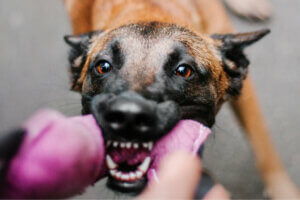How to Read Your Dog's Body Language

You can certainly read your dog’s body language when they make that super cute face. You probably also know exactly when they’re sad. Beware though, there are times when things aren’t what they seem.
The following lines are a review of the main characteristics of the gestures and postures that dogs adapt to in different situations. For sure some of them will be useful, so check them out.
Your dog’s body language
You must begin by separately analyzing each part of the animal’s body. Normally, they reveal attitudes with the whole body, but, due to individual differences in each dog – such as mutilated ones, it’s important to know where else to look to identify these.
The tail
This is the part of the body that humans look at the most to interpret an animal’s mood. Tail wagging is generally identified as joy, although it isn’t so easy to guess emotions based on this.
- Tail wagging indicates excitement, but it can be either joy or nervousness. The greater the excitement, the greater the speed.
- Relaxed oscillation accompanied by movement of the hips indicates joy and a playful attitude.
Other movements of the tail are:
- Stiffness and immobility of the tail show tension in the face of a threat.
- An erect tail, with or without wagging, indicates security.
- Tucking the tail between the legs until the end of the tail touches the abdomen reveals fear.

The ears
The ears, in harmony with the rest of the face, can be quite expressive in conveying moods. However, you may observe the following when looking at each one of them separately:
- Backward facing can be a sign of fear, insecurity, and even defensive aggressiveness. It can also be seen within general postures of appeasement.
- Forward-facing indicates alertness, interest, or confidence. For one reason or another, dogs in this pose are interested in those who are looking at them.
Since the morphology of the ears varies greatly from dog to dog, the best way to know where each of their ears is pointing is to look at its base. This is particularly useful for dogs with large, droopy ears.
The mouth
This is another of the most expressive facial elements in dog body language. Who doesn’t realize there’s danger when canines bare their teeth? Here are the most common dog mouth gestures:
- A relaxed open mouth with the tongue out is usually part of relaxed body attitudes.
- A closed mouth may indicate relaxation or tension — along with the rest of the body.
- The lip corners are extremely important in judging what kind of tension the dog is feeling. Pulled back in a pronounced way is usually fear or appeasement. Is the animal also baring its teeth? It may indicate defensive aggression.
The eyes in a dog’s body language
There are two elements to take into account when analyzing a dog’s eyes. The first is how wide they are and what they’re looking at. The more open wide, the greater the tension. The dog is experiencing fear or terror if you can actually see the sclera. Conversely, their eyes will be narrow when they’re relaxed.
A fixed gaze can mean alertness, a hunting attitude, or a threat. They’ll show the opposite, such as insecurity or fear, by looking away. This doesn’t mean they won’t look at those who are frightening, but they’ll do so from the corner of their eye and with quick glances.
Body posture
The animal’s general posture is sometimes easy to misinterpret. Thus, it’s necessary to read it along with the signals from the rest of their body. This is because they have a position for every emotion — it’s the basis of body language in dogs.
Generally, the straighter the dog is, the safer they’re feeling. This has to do with dominance. A dog who crouches down or even gets on their belly is showing submission. They do it to inhibit aggression from other dogs.
Other interesting signals are:
- Their weight leaning forward is usually a sign of interest, especially in social contexts
- Their weight leaning backwards indicates the opposite: avoidance of the interaction, situation, or object they’re attending to
- One front leg slightly raised indicates alertness or insecurity
- Trunk close to the ground, but hindquarters raised is the usual play posture
- A bristly coat, like tail wagging, indicates excitement, but you must analyze whether it’s aggression or not.
The body language of dogs – signs of calm
By way of conclusion, pay attention to how your canine companion displays certain attitudes and emotions in general. To do this you must know the calming signals — a series of movements and gestures aimed at avoiding conflict. Some of them, like the submissive postures you read about above, are obvious, but others aren’t as much.
In general, a dog who’s uncomfortable with the situation may avert their gaze, turn their head away when they try to sniff their face, lick their muzzle quickly and repeatedly, yawn, and adopt a stiff posture, among other things. Ignoring these signals can trigger an aggressive response, so it’s important to be aware of them.

As you can see, your dog might display several body signals. Are you familiar with all of them? A good understanding leads to good coexistence and the possibility of experiencing many good times with your dog.
You can certainly read your dog’s body language when they make that super cute face. You probably also know exactly when they’re sad. Beware though, there are times when things aren’t what they seem.
The following lines are a review of the main characteristics of the gestures and postures that dogs adapt to in different situations. For sure some of them will be useful, so check them out.
Your dog’s body language
You must begin by separately analyzing each part of the animal’s body. Normally, they reveal attitudes with the whole body, but, due to individual differences in each dog – such as mutilated ones, it’s important to know where else to look to identify these.
The tail
This is the part of the body that humans look at the most to interpret an animal’s mood. Tail wagging is generally identified as joy, although it isn’t so easy to guess emotions based on this.
- Tail wagging indicates excitement, but it can be either joy or nervousness. The greater the excitement, the greater the speed.
- Relaxed oscillation accompanied by movement of the hips indicates joy and a playful attitude.
Other movements of the tail are:
- Stiffness and immobility of the tail show tension in the face of a threat.
- An erect tail, with or without wagging, indicates security.
- Tucking the tail between the legs until the end of the tail touches the abdomen reveals fear.

The ears
The ears, in harmony with the rest of the face, can be quite expressive in conveying moods. However, you may observe the following when looking at each one of them separately:
- Backward facing can be a sign of fear, insecurity, and even defensive aggressiveness. It can also be seen within general postures of appeasement.
- Forward-facing indicates alertness, interest, or confidence. For one reason or another, dogs in this pose are interested in those who are looking at them.
Since the morphology of the ears varies greatly from dog to dog, the best way to know where each of their ears is pointing is to look at its base. This is particularly useful for dogs with large, droopy ears.
The mouth
This is another of the most expressive facial elements in dog body language. Who doesn’t realize there’s danger when canines bare their teeth? Here are the most common dog mouth gestures:
- A relaxed open mouth with the tongue out is usually part of relaxed body attitudes.
- A closed mouth may indicate relaxation or tension — along with the rest of the body.
- The lip corners are extremely important in judging what kind of tension the dog is feeling. Pulled back in a pronounced way is usually fear or appeasement. Is the animal also baring its teeth? It may indicate defensive aggression.
The eyes in a dog’s body language
There are two elements to take into account when analyzing a dog’s eyes. The first is how wide they are and what they’re looking at. The more open wide, the greater the tension. The dog is experiencing fear or terror if you can actually see the sclera. Conversely, their eyes will be narrow when they’re relaxed.
A fixed gaze can mean alertness, a hunting attitude, or a threat. They’ll show the opposite, such as insecurity or fear, by looking away. This doesn’t mean they won’t look at those who are frightening, but they’ll do so from the corner of their eye and with quick glances.
Body posture
The animal’s general posture is sometimes easy to misinterpret. Thus, it’s necessary to read it along with the signals from the rest of their body. This is because they have a position for every emotion — it’s the basis of body language in dogs.
Generally, the straighter the dog is, the safer they’re feeling. This has to do with dominance. A dog who crouches down or even gets on their belly is showing submission. They do it to inhibit aggression from other dogs.
Other interesting signals are:
- Their weight leaning forward is usually a sign of interest, especially in social contexts
- Their weight leaning backwards indicates the opposite: avoidance of the interaction, situation, or object they’re attending to
- One front leg slightly raised indicates alertness or insecurity
- Trunk close to the ground, but hindquarters raised is the usual play posture
- A bristly coat, like tail wagging, indicates excitement, but you must analyze whether it’s aggression or not.
The body language of dogs – signs of calm
By way of conclusion, pay attention to how your canine companion displays certain attitudes and emotions in general. To do this you must know the calming signals — a series of movements and gestures aimed at avoiding conflict. Some of them, like the submissive postures you read about above, are obvious, but others aren’t as much.
In general, a dog who’s uncomfortable with the situation may avert their gaze, turn their head away when they try to sniff their face, lick their muzzle quickly and repeatedly, yawn, and adopt a stiff posture, among other things. Ignoring these signals can trigger an aggressive response, so it’s important to be aware of them.

As you can see, your dog might display several body signals. Are you familiar with all of them? A good understanding leads to good coexistence and the possibility of experiencing many good times with your dog.
All cited sources were thoroughly reviewed by our team to ensure their quality, reliability, currency, and validity. The bibliography of this article was considered reliable and of academic or scientific accuracy.
Rugaas, T., & Ramos, B. P. (2001). El lenguaje de los perros: las señales de calma. Kns.
Bueno, R. Á. (2018). Etología canina: Guía básica sobre el comportamiento del perro. veterinaria.
This text is provided for informational purposes only and does not replace consultation with a professional. If in doubt, consult your specialist.








